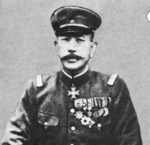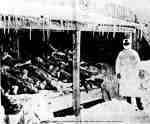
Contrary to what might be expected, Biological Weapons are almost as old as
conventional weapons themselves.
The earliest use of biology in warfare consisted of the hurling of human
bodies infected with plague over enemy fortresses, so as to weaken the besieged
population inside the fortress; the plague epidemic that followed forced the
defenders to surrender. This first recorded use of this tactic was in 1346 by
Tartar army during its siege of Kaffa (in present day Ukraine).
The famous "Catapult" of the Romans (who were known to have
*excellent* war weaponry) was used for the same purpose during their
repeated forays into central Europe. However, exact records of the use of such
weapons by the Romans do not exist. Russian troops may have used the same tactic
against Sweden in 1710.

Image: A
3D reconstruction of the Roman catapult. Click on the image to view a larger
version (800X600) which can also be used as a wallpaper on your computer.
The most well known incident concerning the use of biological warfare occurred
during the war of the White immigrants from England against the native North
American Indians. Sir Jeffery Amherst provided Indians loyal to the French with
smallpox-laden blankets during the French and Indian War of 1754 to 1767. Native
Americans defending Fort Carillon sustained epidemic casualties which directly
contributed to the loss of the fort to the English. It should , however, be
mentioned here that some authorities consider that a certain Capt. Eucyer was
responsible for the act, with the General himself having no knowledge of it at
all.
However, this theory is torn to shreds when you consider the letter Gen. Amherst
wrote to one of his subordinates (Not Capt. Eucyer) regarding the possible
means to end the conflict rapidly:
"Could
it not be contrived to send the Small Pox among
those disaffected tribes of Indians? We must on this occasion use every
stratagem in our power to reduce them."
More recently, there is evidence that during World War I, German agents infected horses and cattle with glanders ( A particular variety of
Pseudomonas) in the U.S. before the animals were transported to France.
Unit 731 :
The behavior of the Japanese in World war 2 was, in many respects,
less than honorable. Hence, it is no surprise that Japan was one of the
nations that was at the forefront of developing biological weapons during that
time.
The main facility of the Japanese Biological weapons program was located in
Manchuria, China (not Japan). There was also a subsidiary unit named Unit 1644
in Nanking, also in China. However, it is to Unit 731 that some of the most
gruesome incidents associated with this kind of warfare are attributed.
Many gruesome atrocities are attributed to Unit 731, including the
vivisection of test subjects, who were mostly Chinese, without anesthesia and
the recorded use of a 3 year old baby and pregnant women for experimentation. However,
what is given below is known for sure and is accepted by all, including the
Japanese.



Images :
(Please click on the images for larger versions. The larger photos open in a separate
window.)
1. General Ishii Shiro, the leader of Unit731
2. The remains of Unit 731 after it was burnt down by the Japanese scientists
themselves in order to destroy evidence after WW2.
3. Heaps of bodies (mostly Chinese, some American) segregated for disposal after
being vivisected.
* Unit 731 used mainly Chinese humans for their experiments. The germs used
were small pox, cholera and anthrax. Around 3000 Chinese (including ordinary
civilians) died during these experiments. Out of these, slightly more than 1000
people were dissected in order to verify the exact efficacy of the attacks.
* In 1941, the Japanese attacked the Chinese city of Changte with Cholera. It is
estimated that 10,000 civilians and 1,700 Japanese soldiers died in the
attack.The attack prompted President Roosevelt to issue a strong statement
of protest on June 5, 1942, warning against Japan by saying that if Japan
continued to use poison gases or other forms of inhuman warfare, it would invite
U.S. retaliation in full measure.
* In a less widely accepted contention, it is said that before making their
escape at the time of Japanese surrender, Japanese in Unit 731 set free scores
of thousands of infected rats that caused widespread plague in 22 counties of
Heilungchiang and Kirin provinces that took more than 20,000 Chinese lives.

Image :
A recent photo of Unit 731, which is now preserved by the Chinese Government as
a symbol of the war atrocities by the Japanese. No larger version available.
After the war, most of the Scientists in Unit 731, including the mastermind
of the whole project the Japanese General Ishii Shiro, were tried in the former
USSR. None of the doctors/scientists involved in the trial (including Gen.
Ishii) were ever sentenced. It is widely believed that Gen. Ishii and others
from Unit731 contributed significantly to the development of USSR's biological
weapons program after the second world war ( For more on Russia's Biological
weapons program, please download "The Weaponeers" from the "Free
Reading Material" section of this article.)
The Biological weapons programs of the US
and USSR:
Although the details of these programs should logically be included here,
this page is already too large and hence, I have included it in the "Rogue
Countries" section of the article.
In brief, the Soviet program was known as "Biopreperat" and
is widely believed to be still active in present day Russia. The main research
facility for this program was the "VEKTOR" laboratory in
Siberia.
 The US program took off in around 1943, with the probable assistance of
Japanese Scientists and research data from Unit 731.The main research facility
was Fort Detrick which was, and still is, a top secret military research
facility (Now renamed as USAMRIID) However, the US officially ended it's
program in 1971-73 and it is believed that the United States currently has no
active offensive biological program.
The US program took off in around 1943, with the probable assistance of
Japanese Scientists and research data from Unit 731.The main research facility
was Fort Detrick which was, and still is, a top secret military research
facility (Now renamed as USAMRIID) However, the US officially ended it's
program in 1971-73 and it is believed that the United States currently has no
active offensive biological program.

![]()